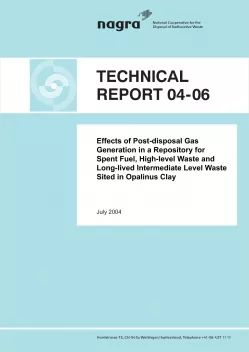
Technical Report NTB 04-06
Effects of Post-disposal Gas Generation in a Repository for Spent Fuel, High-level Waste and Long-lived Intermediate Level Waste Sited in Opalinus Clay
The present study provides a comprehensive treatment of the issue of gas generation in and transport from a repository for spent fuel (SF), vitrified high-level waste (HLW) and long-lived intermediate-level waste (ILW), sited in the Opalinus Clay of the Zürcher Weinland in northern Switzerland (Project Entsorgungsnachweis). It thus provides a synthesis of all information available on the fate of gas, including the original sources of data and the arguments and discussions documented in the Geosynthesis Report (Nagra 2002a), the Safety Report (Nagra 2002c) and the Models, Codes and Data Report (Nagra 2002d).
The issue of how gas generation in and transport from waste repositories may influence disposal system performance has been under study for many years, both at Nagra and internationally. Quantitative analysis is required for a number of reasons: Some of the gases produced may be radioactive (e.g. those containing 14C), thus their release from the repository to the biosphere may represent a radiological hazard. Gas accumulation may eventually result in pressures high enough to damage the engineered barrier system or host rock, or influence groundwater movement. This could potentially affect the transport of dissolved radionuclides. Moreover, in order to establish confidence in the safety case, all significant processes associated with system performance and safety should be addressed appropriately.
The report consists of three main parts:
First, a synthesis of basic information on the host rock and on details of repository construction and wastes is given, focusing on the design and materials aspects that influence gas production and transport from waste emplacement tunnels and projected gas production rates in the repository. The nature and quantities of gas-generating materials and the processes leading to gas production are discussed in detail. The total generated gas is estimated to be 4 × 107 m3 (SATP) for SF/HLW and 5 × 105 m3 (SATP) for ILW, the latter including the contribution from Zircaloy and degradation of organic matter. Based on a steel corrosion rate of 1 μm a-1, complete corrosion of the steel canisters would take about 2 × 105 years, at which time gas production would cease. In the second part of the report, the gas transport characteristics of the engineered barrier system and the geosphere are discussed. The relevant gas transport processes are, i) advective-diffusive transport of gas dissolved in the porewater, ii) visco-capillary two-phase flow, and iii) dilatancycontrolled gas flow. It is shown that gas transport in macroscopic tensile fractures can be ruled out under the expected repository conditions. The gas-relevant properties are discussed for all EBS materials, including bentonite, sand/bentonite mixtures, cementitious mortar and concrete, as well as for the undisturbed host rock, EDZ, steeply dipping faults, confining units and regional aquifer at the site. Finally, the conceptual understanding of gas transport pathways from the emplacement tunnels either through the tunnel system or through the host rock, and further through overlying formations into the biosphere, is presented. The third part discusses the effects of gas on system performance, based on the available information on gas generation, gas transport properties and gas patheways provided in the previous parts of the report. Simplified model calculations based on a mass balance approach for the gas generated within the repository are performed. In a first step, the pressure evolution and gas migration in the SF/HLW/ILW repository are calculated. It is shown that the generated gas is transported through the host rock and the tunnel system and slowly accumulates in the overlying Wedelsandstein formation, from where it is gradually released through diffusion to the Malm aquifer. In a second step, this model is applied to the transport and release of potentially volatile 14C, assumed to be carried with the principal non-radioactive gasses, hydrogen and methane. These calculations suggest that doses in such cases would be well below the regulatory dose limit. The possible displacement of some porewater from the near field into the surrounding rock and/or through the ramp/shaft system due to gas pressure build-up is evaluated in an additional assessment model. In the framework of various assessment cases (base case, parameter variations and "what if?" case) it is shown that the expected doses for such cases are well below the regulatory dose limit.
